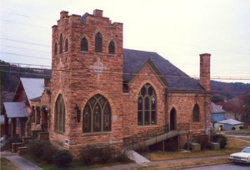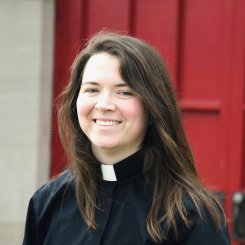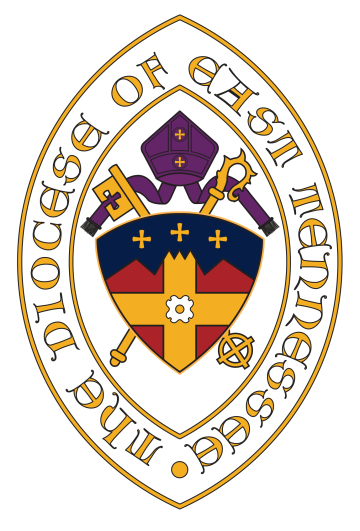Share a story
Thankful Memorial Episcopal Church owes much of its existence to Colonel A. M. Johnson who was born in Gainesville, Georgia in 1830. Johnson came to Chattanooga in 1851 where he went into the tanning business with his brother-in-law, John Bryson. Later, he was given a position as a post office agent on the Nashville and Chattanooga Railroad line. Around this time, he met Thankful Anderson Whiteside, the daughter of Colonel James A. Whiteside one of the founders and leading citizens of early Chattanooga.
Not long after their marriage, Col. Johnson became the superintendent of the Will Valley Railroad. During the Civil War, he operated several railroads in Georgia, serving under the Confederate government with the rank of colonel. When the war was over, the Johnson's returned to Chattanooga to find their home and belongings had been destroyed. Col. Johnson became president of Lookout Savings and with three others bought the City Water Co. (what is now the Tennessee American Water Co.), which was built by Union soldiers. Johnson spent the next seventeen years supervising the construction of the Chattanooga water system.
The outbreak of yellow fever in 1878 caused a panic that sent Chattanooga residents fleeing to the hills and mountains to avoid the disease. Seeing this demand for mountain homes and property, in 1886 Col. Johnson began subdividing lots on the "East side" farm that his wife had inherited from her parents on the eastern slope on the foot of Lookout Mountain. Overlooking the community, the Johnson's built their home, known as "The House", located on two city blocks at the site where Daniel Ross had lived. Johnson named the community St. Elmo after a novel of that name by Augusta Evans, a personal friend of Col. Johnson's wife. Ms. Evans said the view of the new community from Lookout Mountain reminded her of the view of St. Elmo castle in Naples.
St. Elmo had two advantages over the other new suburbs being developed, Johnson installed a water main to provide city water and there was an electric trolley car that connected St. Elmo with Chattanooga. By 1887, the Episcopalians who lived in St. Elmo attended St. Paul's Church in Chattanooga, but it was a long, slow journey even with the available trolley. Thankful Everett, granddaughter of Thankful Johnson recalled, "in the 1890's, the street car and the family horse and carriage were the only means of transportation from St. Elmo to Chattanooga. So attending church was not a simple matter as it took time to make the trip.
Thankful Everett asked St. Paul's for permission to start a children s Sunday School in St. Elmo because many mothers feared their children were not being properly exposed to the practices and beliefs of the Episcopal Church. A preliminary meeting at the Johnson house in 1892 led to the first meeting of The Guild of St. Elmo Sunday School on October 29, 1893 in the brick music hall at the corner of St. Elmo Avenue and 45th Street (the current location of St. Elmo Avenue Baptist Church). W.H. Wilson served as the first superintendent while Col. Johnson served as the first secretary. By 1895, eighteen women taught Sunday classes there. Members of the Guild and their husbands financially supported the school until it became a mission in 1898 when the Rev. Thomas Gailor sent Rev. William G. Robertson from Sewanee to conduct services. In 1899, Mr. Francis Lynde, became the first lay reader of the Episcopal Mission and conducted services along with Rev. Goodman from St. Paul's Church. Under their direction, the Mission became a "semi dependent congregation entirely self-supporting".
When Col. Johnson died in 1903, he left the property across the street from his home to be used for an Episcopal Church to be named in memory of his wife, Thankful Anderson Whiteside Johnson who had died in 1890. So in 1904, the Episcopal Mission ended with the construction of Thankful Memorial Episcopal Church, a church built of native stone in Gothic revival style and filled with several stained glass windows from the Johnson home.
Groundbreaking was held in February 1904, with much of the money for building the church provided through the will of A. M. Johnson. The church bell had been originally given to St. Paul’s in 1870. When “chimes” were presented to St. Paul’s in 1911, the old bell was loaned “in perpetuity” to Thankful Memorial, and still rings to this day.
By 1950, the church’s growth had reached the point to where the mission church became a full-fledged parish of the Diocese of Tennessee.
The organ, Felgemaker’s Op. 495, was originally installed in Christ Church Cathedral, Nashville, in 1889. In 1894, a three-manual Farrand & Votey was installed in the cathedral and the Felgemaker was donated to Thankful Memorial. Restorative repairs were made to the organ in 1987 by the J. F. Nordlie Co. of Sioux Falls. In September of 2004, Nordlie removed the organ for a complete restoration.
The material above is used by permission of Jeffrey C. Webb and his website, www.mysaintelmo.com. Information about the organ and additional historical notes are used by permission of the Chattanooga Chapter of the American Guild of Organists, that has a website at http://www.agochattanooga.org/.
Worship times
Ministries
Jubilee Ministry - St. Elmo Neighborhood Reading Center
Housed in the basement of Thankful Memorial Episcopal Church, the St. Elmo Neighborhood Reading Center is dedicated to instilling in children the desire to read by making available books for children who would otherwise not have them. They do this by reaching out into the St. Elmo/Alton Park community to support, develop, and provide volunteers to reading programs. These programs offer special pre-school story time, reading in Head Start programs, day centers, after-school reading, elementary school age book clubs and special summer reading assistance.
Program Contact: Linda Cooper, Volunteer Director
News about Thankful Memorial Episcopal Church
Share a story
1607 W 43rd St
Chattanooga, TN 37409-1344
United States




